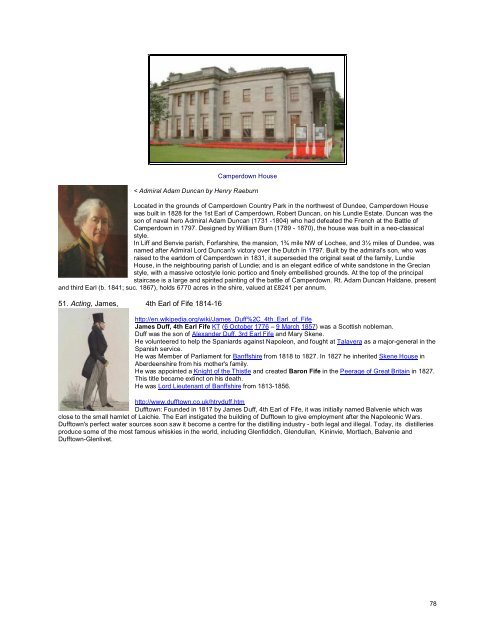Grand Masters of Scotland - Onondaga and Oswego Masonic ...
Grand Masters of Scotland - Onondaga and Oswego Masonic ...
Grand Masters of Scotland - Onondaga and Oswego Masonic ...
You also want an ePaper? Increase the reach of your titles
YUMPU automatically turns print PDFs into web optimized ePapers that Google loves.
Camperdown House<br />
< Admiral Adam Duncan by Henry Raeburn<br />
Located in the grounds <strong>of</strong> Camperdown Country Park in the northwest <strong>of</strong> Dundee, Camperdown House<br />
was built in 1828 for the 1st Earl <strong>of</strong> Camperdown, Robert Duncan, on his Lundie Estate. Duncan was the<br />
son <strong>of</strong> naval hero Admiral Adam Duncan (1731 -1804) who had defeated the French at the Battle <strong>of</strong><br />
Camperdown in 1797. Designed by William Burn (1789 - 1870), the house was built in a neo-classical<br />
style.<br />
In Liff <strong>and</strong> Benvie parish, Forfarshire, the mansion, 1¾ mile NW <strong>of</strong> Lochee, <strong>and</strong> 3½ miles <strong>of</strong> Dundee, was<br />
named after Admiral Lord Duncan's victory over the Dutch in 1797. Built by the admiral's son, who was<br />
raised to the earldom <strong>of</strong> Camperdown in 1831, it superseded the original seat <strong>of</strong> the family, Lundie<br />
House, in the neighbouring parish <strong>of</strong> Lundie; <strong>and</strong> is an elegant edifice <strong>of</strong> white s<strong>and</strong>stone in the Grecian<br />
style, with a massive octostyle Ionic portico <strong>and</strong> finely embellished grounds. At the top <strong>of</strong> the principal<br />
staircase is a large <strong>and</strong> spirited painting <strong>of</strong> the battle <strong>of</strong> Camperdown. Rt. Adam Duncan Haldane, present<br />
<strong>and</strong> third Earl (b. 1841; suc. 1867), holds 6770 acres in the shire, valued at £8241 per annum.<br />
51. Acting, James, 4th Earl <strong>of</strong> Fife 1814-16<br />
http://en.wikipedia.org/wiki/James_Duff%2C_4th_Earl_<strong>of</strong>_Fife<br />
James Duff, 4th Earl Fife KT (6 October 1776 – 9 March 1857) was a Scottish nobleman.<br />
Duff was the son <strong>of</strong> Alex<strong>and</strong>er Duff, 3rd Earl Fife <strong>and</strong> Mary Skene.<br />
He volunteered to help the Spaniards against Napoleon, <strong>and</strong> fought at Talavera as a major-general in the<br />
Spanish service.<br />
He was Member <strong>of</strong> Parliament for Banffshire from 1818 to 1827. In 1827 he inherited Skene House in<br />
Aberdeenshire from his mother's family.<br />
He was appointed a Knight <strong>of</strong> the Thistle <strong>and</strong> created Baron Fife in the Peerage <strong>of</strong> Great Britain in 1827.<br />
This title became extinct on his death.<br />
He was Lord Lieutenant <strong>of</strong> Banffshire from 1813-1856.<br />
http://www.dufftown.co.uk/htryduff.htm<br />
Dufftown: Founded in 1817 by James Duff, 4th Earl <strong>of</strong> Fife, it was initially named Balvenie which was<br />
close to the small hamlet <strong>of</strong> Laichie. The Earl instigated the building <strong>of</strong> Dufftown to give employment after the Napoleonic Wars.<br />
Dufftown's perfect water sources soon saw it become a centre for the distilling industry - both legal <strong>and</strong> illegal. Today, its distilleries<br />
produce some <strong>of</strong> the most famous whiskies in the world, including Glenfiddich, Glendullan, Kininvie, Mortlach, Balvenie <strong>and</strong><br />
Dufftown-Glenlivet.<br />
78







![Richard [Nicholls] Harison / Harrison - Onondaga and Oswego ...](https://img.yumpu.com/24950065/1/190x245/richard-nicholls-harison-harrison-onondaga-and-oswego-.jpg?quality=85)

![Richard [Nicholls] Harison / Harrison - Onondaga and Oswego ...](https://img.yumpu.com/24950063/1/190x245/richard-nicholls-harison-harrison-onondaga-and-oswego-.jpg?quality=85)







